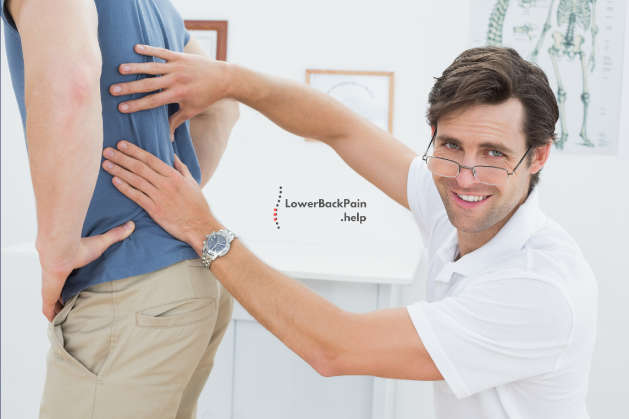Table of Contents
Your sciatic nerve is a long nerve that runs from the bottom of your lower spine down either leg.
The nerve runs all the way down to your feet, making it easy to irritate or inflame it as a result of another condition like a herniated disc.
But while sciatica can be caused by lots of possible sources, its symptoms are relatively uniform and are similar to general lower back pain.

Usually, sciatica results in general lower back discomfort and pain, particularly along the one leg and/or buttock.
This pain can eventually progress to numbness and weakness in the affected limb, although this normally only occurs in more serious cases.
We have put together a page where you will learn the basics of Sciatica – and the most common Sciatica Symptoms.
Regardless of your symptoms, the best treatments for Sciatica depend on your symptoms and the level of nerve damage.
Let’s go over these based on their intensity.
Non-Surgical Treatments
Most sciatica treatments are nonsurgical. They can be accomplished at home or with minor medical assistance.
Physical Therapy
Your doctor may prescribe you a physical therapist to assist with this treatment, or you might take it upon yourself.
Either way, physical therapy involves developing a stretching and exercise routine that regularly flexes the spine and improves your posture.
You’ll also likely build up better lower body strength in the process.
Poor posture is one of the leading causes of sciatica as a result of spine compression and the requisite pinching of the sciatic nerve. You may also need to adopt different sitting habits, such as using a standing desk at work or purchasing an ergonomic chair that provides adequate lower back support.
Bed Rest
Many people who have low to moderate sciatica pain will be prescribed bed rest.
Some years ago most people thought that Bed Rest and a few days off your feet with a minimum of disturbance to your spine is enough to restore things to normal.
However, studies show that the opposite of Bed Rest is what helps the most with lower back pain in general. You should therefore walk and try to move like normal.
What is also important is that you have a firm mattress that provides as much support for your lower back as possible.
Dieting
Many doctors will prescribe dieting and exercise, as gaining weight is accompanied by lower back pain and sciatica for some.

As you gain weight, particularly around the middle, your spine is compressed around the lower back.
Your spine can accommodate this to some extent, but over time and may cause a herniated disc or general discomfort in the surrounding muscle tissue.
Gaining weight can occasionally lead to sciatica as your body tissues are compressed and your spine curves.
If your physician determines that weight gain is the reason for your sciatica, they will likely prescribe you a dietitian and an exercise regimen. Losing weight is one of the best ways to improve lower back pain in the long term.
Hot or Cold Packs
Another easy home remedy for sciatica is to use hot or cold packs. These alternatively numb and relax your muscles, which both reduces irritation and potentially freeze your sciatic nerve from any muscles that may have it in a vice grip.
Pain Relief
Of course, those suffering from sciatica who must also go to work can use regular over-the-counter pain relievers like ibuprofen.
These are only short-term solutions, however, and should not be relied upon for long-term sciatic relief.
Your doctor may prescribe more intensive pain relievers or medicines if normal ones don’t do the trick.
These will usually be anti-inflammatories or muscle relaxants. Occasionally, antiseizure medications will be used. A final alternative is a steroid injection directly into the sciatic nerve, which has provided relief for some in the past.
Surgical Treatments
You can only receive surgical treatment for sciatica if your doctor determines that your symptoms are intense enough to warrant a more invasive procedure.
Surgery is reserved for cases where the patient feels intense pain for prolonged periods of time, such as lengths of six weeks or more. They may also prescribe surgery if they scan your spine and determine extensive nerve damage has occurred.
Numbness or the loss of control in the bowels or bladder is generally a big sign that surgery is required, as it shows that the sciatic nerve is in much worse shape than with most patients.
Diskectomy
This is the most common sciatic surgical procedure.
In this procedure, a surgeon will remove whatever is pushing on the sciatic nerve.
This can be multiple things, either alone or at once.
Examples include bone spurs or herniated discs, both of which occur frequently in the lower back and so are typical causes for this condition.
The actual procedure will depend on what is pushing on your sciatic nerve.
For instance, a herniated disc will be repaired or pushed back into place rather than removed, as the disc is necessary for regular movement and health.
Only occasionally will a herniated disc be fully removed. A bone spur will almost always be totally removed from your body, however.
This procedure will be done under general anesthesia, although it usually only takes a few hours and most patients are allowed to return home the same day.
Laminectomy
The second major sciatica treatment deals with the lamina, which is a portion of the ring of bone that normally covers the spinal cord.
In this procedure, a surgeon will remove the lamina and any surrounding tissue that might be pressing on your sciatic nerve.
Like the prior procedure, this is done under general anesthesia, and it only takes around an hour.
You’ll also be able to go home the same day in most cases, although few cases require patients to remain at the hospital overnight in case of complications.
Conclusion
Regardless of the cause or exact symptoms of your sciatica, take comfort in the fact that there are multiple treatment options available to you. Sciatica is far from a life-ending condition and can always be fixed, whether you require surgery or can rely on at-home remedies to do the trick.
Just be sure to visit a doctor if you think you have sciatica so you can begin treatment right away.
